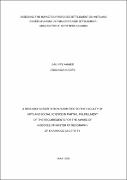| dc.description.abstract | Wetland use and cover changes are a serious problem in many areas of Uganda, as in the Rhino camp of Arua where Refugee settlement and local community have induced wetland degradation and rapid cover change. This study assessed the implication of Refugee settlement on wetland cover changes in the Rhino settlement. Specifically, the study to assessed the magnitude of wetland cover changes; determined the effect of wetland use on spatial landscape structures and examined the determinants of fire wood and charcoal production as a major proxy of wetland use. In this study, Using non-supervised classification algorithm and the post-classification change detection technique in GIS, the magnitude of wetland cover changes were investigated. With the Fragstats software, it was possible to quantify the changes of the spatial landscape structures in the Rhino settlement for the five years period (2015-2019). Socioeconomic data was collected using questionnaire guide, key information interview guide, focus group discussion guide and observation guide. It was used purposely to generate both qualitative and quantitative data. It was also intended to get deeper views and perceptions of respondents about the study variables. The findings indicated that wetland in the Rhino settlement decreased by 7% at the expense of subsistence farming and built up that increased by 15% and 1.3%, respectively. Analysis of landscape metrics generally indicated that natural wetland cover has been destroyed during this period along with increasing anthropogenic impacts for example the class area (CA) reduced by 37.4% signifying changes in biodiversity. Degradation and replacement of natural cover with human activities is considered undesirable development on the Rhino wetland. It is therefore recommended that the government through the environmental officers and all environmental activists including NGOs, stand together to monitor and control the unfavorable anthropogenic activities in the Rhino wetland. In addition, the government through NEMA should demarcate the boundaries of Rhino wetlands, which should be out of bound from human activities so as to maintain its functionality. | en_US |

